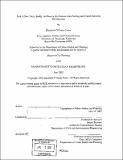| dc.contributor.advisor | Frederick P. Salvucci. | en_US |
| dc.contributor.author | Curtis, Elizabeth O'Grady, 1977- | en_US |
| dc.contributor.other | Massachusetts Institute of Technology. Dept. of Urban Studies and Planning. | en_US |
| dc.date.accessioned | 2011-08-30T15:39:06Z | |
| dc.date.available | 2011-08-30T15:39:06Z | |
| dc.date.copyright | 2002 | en_US |
| dc.date.issued | 2002 | en_US |
| dc.identifier.uri | http://hdl.handle.net/1721.1/65470 | |
| dc.description | Thesis (M.C.P.)--Massachusetts Institute of Technology, Dept. of Urban Studies and Planning, 2002. | en_US |
| dc.description | Text printed 22 x 29 cm. and bound 29 x 22 cm. | en_US |
| dc.description | Includes bibliographical references (leaves 50-52). | en_US |
| dc.description.abstract | Land use planning and regulation is essentially a task of balancing priorities and making choices. The choices made over the better part of the 20th century prioritized separation of uses and low-density development, which has ultimately led to suburban sprawl and traffic congestion. One of the most significant choices has been and continues to be the choice between automobile infrastructure, such as parking, and human-scale development. Many small choices, made over a long time frame, have been made with an assumption that the provision of parking is a public good. Consequently, parking has been prioritized over other public goods, such as sidewalks, trees, and a sense of place. Experience has shown that parking in fact generates negative externalities, from pollution to traffic congestion. The typical responses to negative externalities - regulation and pricing- are infrequently applied to parking. If we choose to prioritize quality of life, community, and environmental sustainability over automobile dominated development, our attitude towards parking must change. In this thesis I explore the general relationship between parking policy and sprawl and focus on the conflict between parking and development in the area of transit stations. I argue that station-area parking issues must be resolved for Transit-Oriented Development to become an effective method of addressing sprawl and making better communities. I also argue that the design quality of station-area parking lots and structures is an important factor in the success of Transit-Oriented Development. To support these arguments, I investigate the relationship of station-area parking to Transit-Oriented Development. I explore the decision making processes which lead to the allocation and design of the station-area parking supply and investigate design techniques which minimize conflicts between drivers and other stakeholders in the station area. I make general design and policy recommendations for station-area parking and more specific recommendations for Tren Urbano, a new heavy-rail rapid transit system in Puerto Rico. I also briefly mention specific financial strategies for addressing parking externalities, such as a regional parking tax. | en_US |
| dc.description.statementofresponsibility | by Elizabeth O.Grady Curtis. | en_US |
| dc.format.extent | 52 leaves | en_US |
| dc.language.iso | eng | en_US |
| dc.publisher | Massachusetts Institute of Technology | en_US |
| dc.rights | M.I.T. theses are protected by
copyright. They may be viewed from this source for any purpose, but
reproduction or distribution in any format is prohibited without written
permission. See provided URL for inquiries about permission. | en_US |
| dc.rights.uri | http://dspace.mit.edu/handle/1721.1/7582 | en_US |
| dc.subject | Urban Studies and Planning. | en_US |
| dc.title | Park it over there, buddy : an inquiry into station-area parking and transit-oriented development | en_US |
| dc.type | Thesis | en_US |
| dc.description.degree | M.C.P. | en_US |
| dc.contributor.department | Massachusetts Institute of Technology. Department of Urban Studies and Planning | |
| dc.identifier.oclc | 50854714 | en_US |
